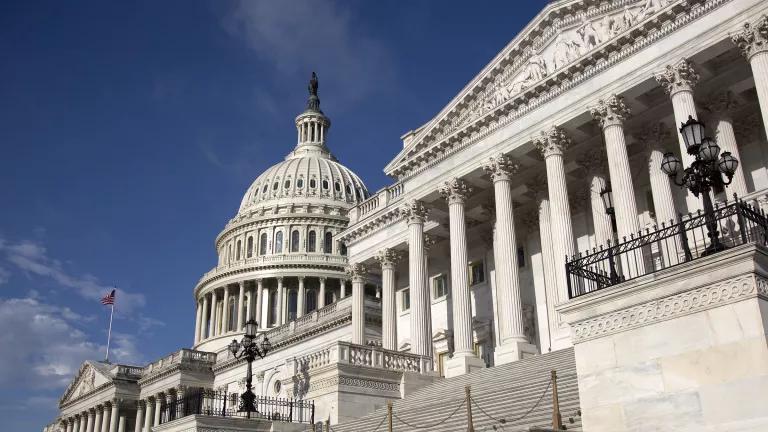Standing Up for Safety on Nuclear Energy
NRDC’s nuclear program this year stayed focused on the key mission of ensuring safeguards on the industry—from cradle to grave.

Watts Bar Nuclear Plant in Tennessee
Charles Knowles/Dreamstime
Part of NRDC’s Year-End Series Reviewing 2022 Climate and Clean Energy Developments
In a year when Congress focused on providing billions of dollars in new subsidies for the owners of aging nuclear plants, NRDC’s nuclear program stayed focused on the key mission of ensuring safeguards on the nuclear industry, from cradle to grave.
NRDC worked with our longtime partners to fight for long-overdue standards to protect precious Western water sources from uranium mining, hold firm on health standards for radiation exposure, ensure nuclear plants consider the impact of climate change when asking to operate for decades longer, and press for transparency in the new subsidies for nuclear plants.
EPA’s delay on uranium mining rule
In April, NRDC worked with longtime partners such as the New Mexico Environmental Law Center and the Powder River Basin Resource Council to press the U.S. Environmental Protection Agency (EPA) to propose new standards for in situ leach uranium mining. In the wake of Russia’s unprovoked invasion of Ukraine, all of the groups supported a ban on Russian uranium imports but added a key stipulation: “Any ban on Russian uranium must be accompanied by EPA finally moving forward on environmental standards that ensure U.S. uranium mining projects don’t foul precious underground aquifers and water supplies or sicken and kill wildlife.”
In 2016, EPA was oh, so close to adopting these standards, but pulled them back at the very end of the Obama administration. Now, Western communities and residents are still waiting for the protections they deserved years ago. As the groups write:
“Continued delay in reissuing and implementing the proposed rule is particularly concerning because of the environmental justice implications that (in situ leach) mining raises. The majority of (in situ leach) mining occurs or is proposed in low-income communities and communities of color, particularly Native communities. The health effects and natural resource destruction from historic uranium development already overburden these communities. Further delay in implementing the proposed rule would be antithetical to the administration’s stated commitment to environmental justice and equity.”
Sadly, the leadership of EPA has so far failed to act on this critically important regulation, leaving people—and the water resources they depend on—wondering what it will take to get action and why nothing has happened yet.
Standing up for radiation safety
There is a hypothesis that radiation exposure in low doses is good for you and, as a result of the last administration’s prodding, the National Academies of Sciences, Engineering, and Medicine (NAS) launched a review of the health impacts of low doses of radiation. The political reasons for this panel and its composition left many of us in the environmental and public health communities concerned.
However, the NAS panel, with input and a review from NRDC radiation health physicist Bemnet Alemayehu (allied with key regional environmental and public health advocates), wrote a thorough report and concluded in June that “there are long-standing concerns that such (low) exposure could negatively affect human health. Although cancer has been linked to low-dose radiation exposure for decades, there is increasing evidence that low-dose radiation exposure may also be associated with cardiovascular disease, neurological disorders, immune dysfunction, and cataracts.” The NAS panel came out in the right place in defense of sound, public health–focused science.
For more on this issue and what is at stake, please see Alemayehu’s blog: https://www.nrdc.org/experts/bemnet-alemayehu/putting-people-first-low-dose-radiation-research
Aging reactors and climate change
Early in 2022, NRDC secured a legal win that sets important precedent in favor of health, safety, and environmental protection. Nuclear power plant operators have begun their applications to extend the operating life of their reactors to 80 years. This is twice the originally planned operating life of a reactor, an unprecedented number worldwide, and a prospect that no one person, regulator, or even country has ever analyzed, especially not in light of the drastically changing climate. Even so, operators attempted this extension, relying on a generic environmental review that had been prepared in 1996, had been revised in 2013, and that only looked at operating a reactor for a total of 60 years; the analysis failed to include additional aging concerns or increased climate impacts like sea level rise or stronger storms.
NRDC and our partners Friends of the Earth and Miami Waterkeeper argued that reliance on this generic, fundamentally weak scientific and technical analysis was legally deficient and unsafe. And after a multiyear legal battle before the agency, the U.S. Nuclear Regulatory Commission agreed with us. Because of our advocacy, the commission is now requiring a new look at the environmental effects of operating an aging reactor beyond the 2050s, holding the nuclear industry to the necessary accountability and review.
Transparency of subsidies
Over the past two years, Congress has successfully passed historic climate legislation, including the Infrastructure Investment and Jobs Act and the Inflation Reduction Act. As with nearly every piece of comprehensive legislation, there are aspects included in the legislation that we don’t love and, based on decades of experience, we don’t think they will be particularly helpful in the long-term fight to reduce greenhouse gases. So as federal agencies began implementing these Acts and setting the rules for how they would dole out the single-largest investment in climate solutions ever, we worked to ensure that those decisions were made fairly and transparently. Our nuclear team submitted comments to the Internal Revenue Service and the Department of Energy (DOE), asking for the government to put transparency first. As the department remains reluctant to share how it is making decisions about billions in taxpayer dollars, we have submitted a Freedom of Information request to learn more. We will continue to demand public transparency of government processes over confidentiality of industry submissions.
A key moment for environmental safeguards
In addition to the work above, NRDC’s nuclear team has also been busy with our efforts alongside Representative Mike Levin (CA-49)) and Senator Ed Markey (D-MA) to have Congress finally find a publicly acceptable and scientifically defensible path forward for nuclear waste; and writing extensive comments before federal agencies on topics such as the decommissioning rules for nuclear power plants and the DOE’s request for information on uranium matters and the front end of the nuclear fuel cycle. We’re at a key moment for the nuclear industry and, indeed, America and the world’s power sector. Ensuring sound environmental safeguards are in place will be crucial for whatever the next decade brings.




